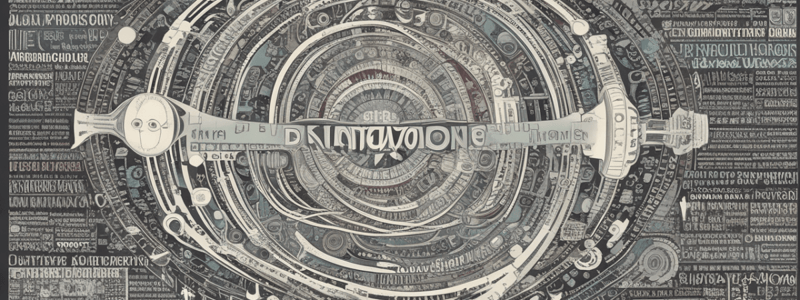Podcast
Questions and Answers
What type of innovation may not be perceived as such by suppliers, customers, or complementary innovators?
What type of innovation may not be perceived as such by suppliers, customers, or complementary innovators?
- Radical innovation
- Incremental innovation (correct)
- Disruptive innovation
- Competence-enhancing innovation
Why may an incumbent firm still succeed despite a competence-destroying innovation?
Why may an incumbent firm still succeed despite a competence-destroying innovation?
- Because the innovation is radical
- Because the innovation is incremental
- Because the innovation is competence-enhancing to its value chain (correct)
- Because the innovation is disruptive
What is a key factor in a firm's success in exploiting an innovation?
What is a key factor in a firm's success in exploiting an innovation?
- The type of innovation
- The size of the firm
- What the innovation does to the firm's capabilities (correct)
- The industry the firm operates in
According to Figure 2.7, what is impacted by an innovation?
According to Figure 2.7, what is impacted by an innovation?
What is meant by an innovation being 'competence-enhancing' to a firm's value chain?
What is meant by an innovation being 'competence-enhancing' to a firm's value chain?
What is a potential advantage of an innovation being competence-enhancing to a firm's value chain?
What is a potential advantage of an innovation being competence-enhancing to a firm's value chain?
What is the main argument made about innovation in the given content?
What is the main argument made about innovation in the given content?
What is the implication of an innovation being 'competence-destroying' for a firm?
What is the implication of an innovation being 'competence-destroying' for a firm?
What is the role of suppliers, customers, and complementary innovators in the context of innovation?
What is the role of suppliers, customers, and complementary innovators in the context of innovation?
What is the focus of some research regarding innovation?
What is the focus of some research regarding innovation?
What is the relationship between a firm's size and market power, and its innovative activity?
What is the relationship between a firm's size and market power, and its innovative activity?
What is the definition of innovation used in the text?
What is the definition of innovation used in the text?
What is the impact of an innovation on a firm's ability to offer products?
What is the impact of an innovation on a firm's ability to offer products?
What is the difference between incremental and radical innovation?
What is the difference between incremental and radical innovation?
What is the role of knowledge in a firm's ability to offer products?
What is the role of knowledge in a firm's ability to offer products?
What is the impact of an innovation on a firm's knowledge?
What is the impact of an innovation on a firm's knowledge?
What is the relationship between innovation and a firm's competitiveness?
What is the relationship between innovation and a firm's competitiveness?
What is the focus of the static models of innovation?
What is the focus of the static models of innovation?
What is a characteristic of a radical innovation?
What is a characteristic of a radical innovation?
Who first suggested that small entrepreneurial firms were the sources of most innovations?
Who first suggested that small entrepreneurial firms were the sources of most innovations?
What is an example of a radical innovation in the economic sense?
What is an example of a radical innovation in the economic sense?
What is a characteristic of an incremental innovation?
What is a characteristic of an incremental innovation?
Why did Schumpeter later change his view on who is most likely to innovate?
Why did Schumpeter later change his view on who is most likely to innovate?
What is a consequence of a radical innovation?
What is a consequence of a radical innovation?
Which of the following is an example of an incremental innovation?
Which of the following is an example of an incremental innovation?
What is the main difference between radical and incremental innovations?
What is the main difference between radical and incremental innovations?
Who is more likely to innovate, according to Schumpeter's later view?
Who is more likely to innovate, according to Schumpeter's later view?
What is the main concept depicted in the diagram?
What is the main concept depicted in the diagram?
What is the direction of the arrows in the diagram?
What is the direction of the arrows in the diagram?
What is the purpose of the value-added chain?
What is the purpose of the value-added chain?
What is the first stage of the value-added chain?
What is the first stage of the value-added chain?
What is the relationship between the stages in the value-added chain?
What is the relationship between the stages in the value-added chain?
What is the final stage of the value-added chain?
What is the final stage of the value-added chain?
What is the advantage of large firms in R&D according to the argument?
What is the advantage of large firms in R&D according to the argument?
What is the purpose of the arrows between the stages?
What is the purpose of the arrows between the stages?
Why do large firms have an advantage in commercializing an invention?
Why do large firms have an advantage in commercializing an invention?
What is the underlying concept of the value-added chain?
What is the underlying concept of the value-added chain?
What is the main benefit of the value-added chain?
What is the main benefit of the value-added chain?
What is the advantage of large firms in terms of capital access?
What is the advantage of large firms in terms of capital access?
Why do large firms not face competition in innovating?
Why do large firms not face competition in innovating?
What do large firms have that allows them to exploit economies of scale in R&D?
What do large firms have that allows them to exploit economies of scale in R&D?
What is the result of large firms being more diversified?
What is the result of large firms being more diversified?
What is the advantage of large firms in terms of innovation?
What is the advantage of large firms in terms of innovation?
Why do large firms have an advantage in R&D?
Why do large firms have an advantage in R&D?
What is the relationship between large firms and their competitors?
What is the relationship between large firms and their competitors?
Flashcards are hidden until you start studying
Study Notes
Types of Innovation
- A radical innovation results in a product that is so superior (lower cost, better attributes, or new attributes) that existing products are rendered noncompetitive.
- An incremental innovation allows existing products to stay competitive.
Who Innovates?
- The debate over who is most likely to innovate dates back to Schumpeter, who suggested that small entrepreneurial firms were the sources of most innovations.
- Later, Schumpeter changed his view and suggested that large firms with some degree of monopoly power were more likely to be the sources of technological innovation.
- Large firms have the production and other complementary assets necessary to commercialize an invention, exploit economies of scale in R&D, and have better access to capital.
Incremental vs Radical Innovation
- Whether incumbents or new entrants are able to introduce and exploit innovation is a function of whether the innovation is incremental or radical.
- The type of innovation (incremental or radical) depends on how new the new knowledge and the new product are.
Impact of Innovation on a Firm
- An innovation has two kinds of impact on a firm: it changes the firm's ability to offer products and it affects the firm's capabilities and its value-added chain.
- An innovation can be competence-destroying or competence-enhancing to a firm's value-added chain.
- A firm's success in exploiting an innovation may depend as much on what the innovation does to the capabilities of its value-added chain as on what it does to the firm's capabilities.
Studying That Suits You
Use AI to generate personalized quizzes and flashcards to suit your learning preferences.




